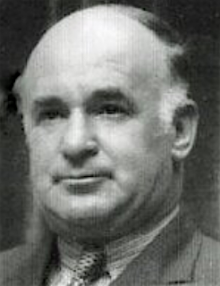
Thomas Smith Tait was born the son of a stonemason, in Paisley, Scotland, on 18 June 1882. He studied architecture at Paisley Technical College (1900-03; Glasgow School of Art under Charles Rennie Mackintosh; and at the Royal Academy Schools in London. He was articled to the Paisley architect John Donald (1852?-1914) from 1896 to 1903 following which he worked as an assistant to James John Burnet (1857-1938) from 1903 to 1914.
He was also employed by the London architects Trehearne & Norman. In 1910 he collaborated with James Mitchell Whitelaw (1886-1913) and Cecil Alfred Leonard Sutton (1886-1965) to enter a competition to design Marylebone Municipal Buildings. Their entry is illustrated in British Competitions in architecture vol. 3, no. 36, August 1911 (pp. 373-374). From 1918 to 1930 he was in partnership with Burnet. In 1930 Francis Lorne (1889-1963) joined the practice which became Burnet, Tait & Lorne, The partnership was dissolved in c.1949.
In 1936 Tait was appointed Chief Architect of the Empire Exhibition, Scotland 1938 by the Scottish Development Council. He subsequently chose Bellahouston Park in Glasgow as the site for the exhibition for which developed the master-plan . He was also responsible for designing most of the buildings on the site for which he was assisted by a team of architects who included Basil Spence (1907-1976). The most notable building designed by Tait for the exhibition was the Tower of Empire, a 300-feet,high structure, commonly known as Tait's Tower, which dominated site.
During World War Two, Tait was employed by the Ministry of Works as Director of Standardisation from 1940 to 1942. He resumed his practice after the war and retired in 1952.
Tait was elected an Associate of the Royal Institute of British Architects (ARIBA) in 1913 and a Fellow of the Royal Institute of British Architects (FRIBA) in 1926. In 1933 he was awarded the RIBA Royal Gold Medal.
Tait died in Aberfeldy, Scotland, on 18 July 1954.
Kodak House in Kingsway, London (1910), the north wing of the British Museum in London (1914), Adelaide House in London (1920-25), the Church of Christ Scientist in Kensington Palace Gardens in London (1926), the Silver End estate village for Crittall Metal Windows near Braintree, Essex (1926-28), Unilever House, London (1930–33), the Hospital for Infectious Diseases in Paisley (1932-38), the Royal Masonic Hospital, Ravenscourt (1930-33), houses in St John's Wood, London (1934-36), the Curzon Cinema in Mayfair, London (1938), the layout of the Empire Exhibition, held at Glasgow's Bellahouston Park in 1938, Saint Dunstan's Hospital for the Blind near Brighton, Sussex (1938), and Saint Andrew's House in Edinburgh (1939). Following World War One Tait received commissions to design several war memorials including the Great Western Railway War Memorial at Paddington Station, London, unveiled on Armistice Day 1922.
______
For an additional lists of architectural projects by Thomas Smith Tait see the Dictionary of Scottish Architects 1660-1980; Historic England; Historic Environment Scotland [links below]
Baxter, J. Neil. ‘Thomas S. Tait and the Glasgow Empire Exhibition 1938’. The Thirties Society Journal no,.4, 1984 pp.26-30
Baxter, J. Neil. Thomas Tait and the Glasgow Empire Exhibition, 1938. M.A. thesis, University of Glasgow, 1982
Caswell, Dawn. ‘The economy of style: Thomas S Tait and the interiors of St Andrews House’. Architectural Heritage vol. 10, 1998 pp.74-89
Caswell, Dawn E. ‘Thomas Tait and St Andrews House: A 1930s Scottish Public Interior’. M.A. thesis, University of Glasgow, 1997
Crampsey, Robert A. The Empire Exhibition of 1938. Edinburgh: Mainstream 1988
Directory of British Architects 1834-1914. Compiled by Antonia Brodie, et al. Volume 2: L-Z. London; New York: British Architectural Library, Royal Institute of British Architects/Continuum, 2001
Harwood, Elain. Art Deco Britain: Buildings of the Interwar Years. London: Batsford, 2019
‘Obituary’. Architects' Journal vol. 120, 22 July 1954 p. 97
‘Obituary’. Architectural Review vol. 116, September 1954 p. 141
‘Obituary’. The Builder vol. 187, 23 July 1954 p. 126
‘Obituary’. RIBA Journal vol. 61, August 1954 p. 427
Reilly, C. H. ‘T. S. Tait’. Building October 1931 pp. 444-449
Thomas Tait: The Last Empire Builder (Architect 1882-1954). Paisley, Scotland: Paisley Museum & Art Galleries, 1998